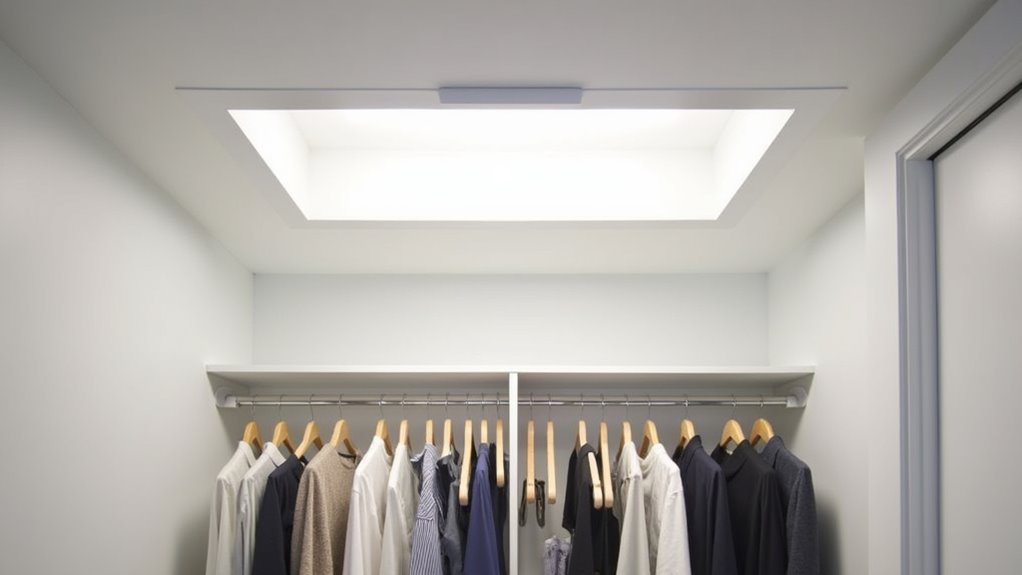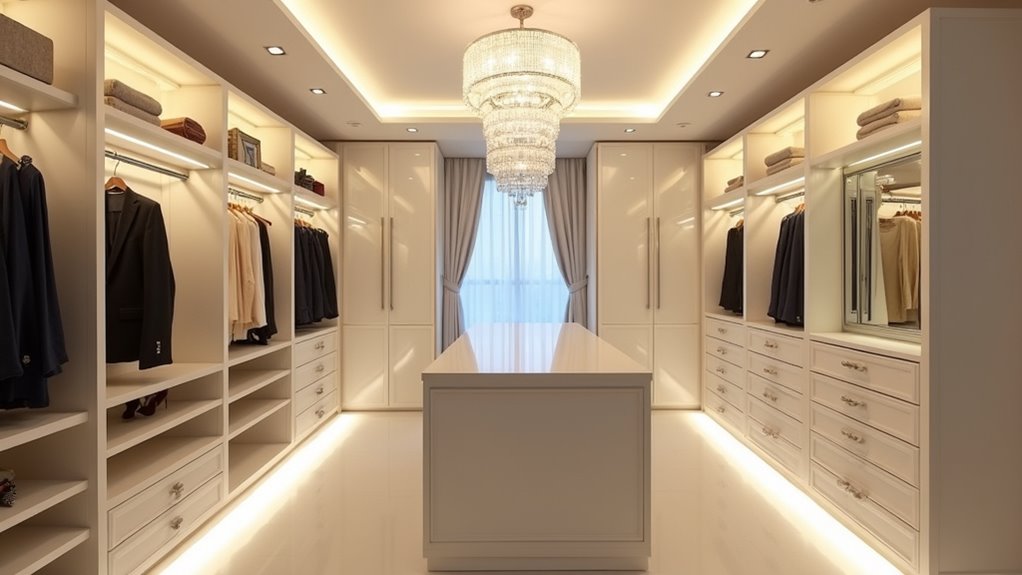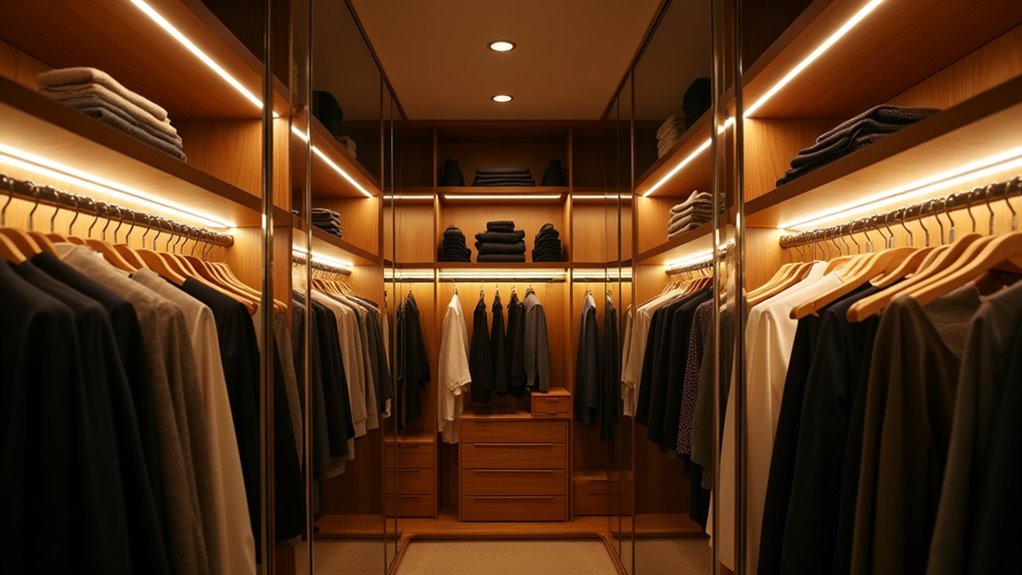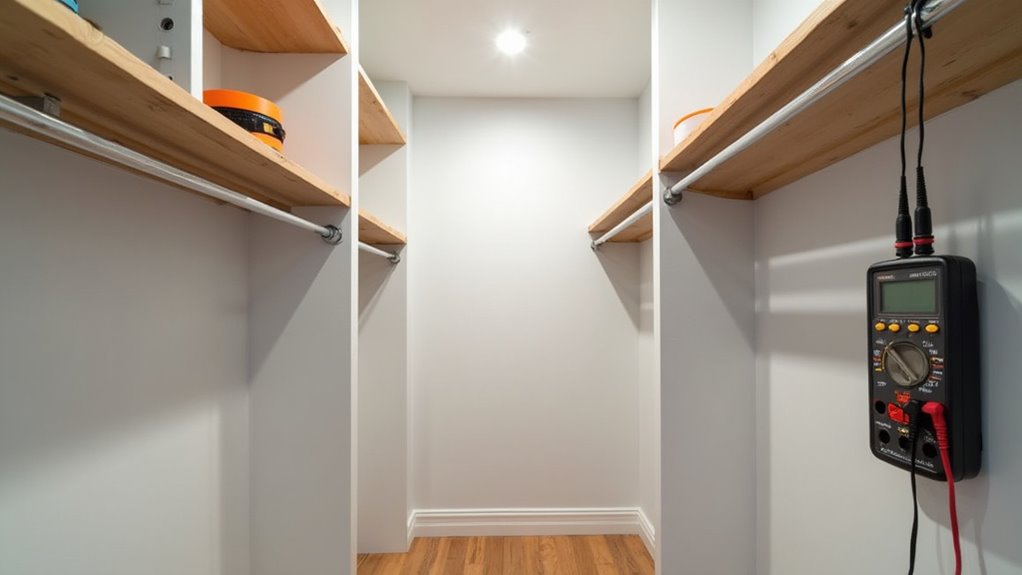You’ll find LED flush mount fixtures work best for standard reach-in closets, delivering 810–1200 lumens with uniform distribution that eliminates shadows. For walk-ins, recessed lighting in perimeter arrangements provides superior coverage across multiple zones. LED strip lights excel at targeted illumination under shelves, while track systems offer adjustable beam direction for larger wardrobe spaces. Motion sensors add hands-free convenience, and 4000K color temperatures guarantee accurate clothing selection. The following sections address how each fixture type addresses specific spatial requirements and lighting challenges.
LED Flush Mount Fixtures for Everyday Closet Needs
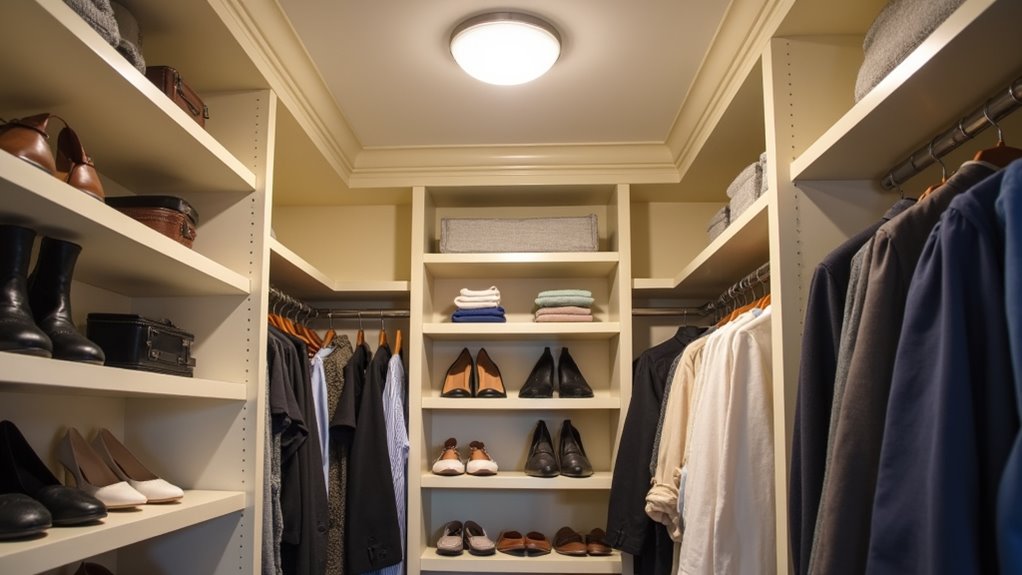
Modern LED flush mount fixtures transform closet functionality through intelligent design and substantial energy efficiency. You’ll achieve up to 80% energy savings compared to incandescent alternatives while benefiting from 50,000-hour lifespans that eliminate frequent bulb replacements.
These fixtures deliver uniform light distribution through their ceiling-hugging profiles, creating shadow-free illumination essential for wardrobe selection. Models operating at 10–18 watts produce 810–1200 lumens, while 4000K color temperatures guarantee accurate color rendering with CRI ratings above 80.
Select 7–12 inch diameters for closets under 100 square feet, choosing finishes, brushed nickel, classic white, or contemporary designs, that complement your existing aesthetic appeal. Frosted glass diffusers reduce glare, and slim profiles under 2 inches deep optimize overhead clearance. Damp location ratings and shatter-resistant lenses assure safe, long-term performance in confined spaces. Easy installation typically requires only minutes with all necessary mounting hardware included for flush mounting to walls or ceilings. Consider layering lighting sources with LED strip lights along shelving or hanging rods to create enhanced depth and functional illumination throughout your closet space.
Recessed Lighting Solutions for Walk-In Closets
Recessed lighting solutions augment walk-in closets from utilitarian storage into sophisticated dressing environments through strategic ceiling integration. You’ll achieve superior lighting efficiency ratios, LED fixtures consume 90% less energy than incandescent alternatives while delivering improved illumination across every storage zone. Their discreet profile designs maintain spatial flow without obstructing shelves or hanging rods.
Consider these placement strategies for ideal coverage:
- Perimeter arrangement: Position fixtures every 3-4 feet along ceiling edges to eliminate shadows on vertical storage surfaces
- Zone highlighting: Install dedicated downlights above shoe racks, accessory displays, and island cabinetry
- Dimmable circuits: Integrate adjustable controls for task-specific brightness, full intensity for color matching, ambient settings for evening access
Unlike flush-mount alternatives, these lights are sunken directly into your ceiling structure, creating a seamless architectural appearance. Multiple recessed lights installed strategically provide even coverage throughout larger walk-in spaces. Professional installation is recommended for complex recessed lighting configurations to ensure electrical safety compliance. This minimalist approach transforms your closet into an organized, visually refined space while reducing replacement frequency and utility expenses.
LED Strip and Bar Lights for Targeted Task Lighting
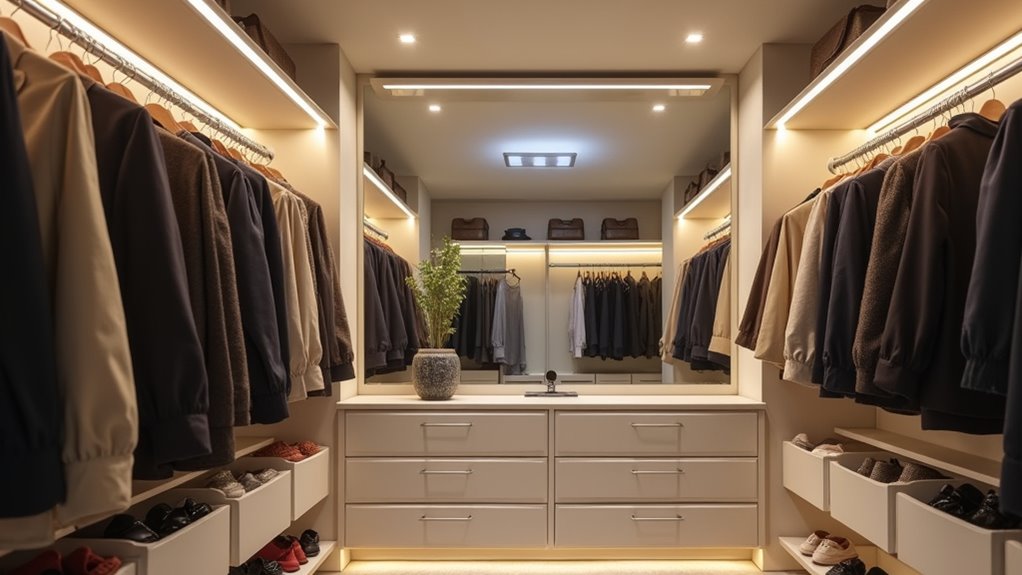
While recessed fixtures provide ambient illumination from above, LED strip and bar lights deliver precision targeting at the exact point where you interact with your wardrobe. This distinction between linear vs focused lighting fundamentally shapes closet functionality, strip lights wrap continuously along shelves and hanging rods, eliminating shadows through uniform distribution, while bar lights concentrate illumination on specific task zones.
You’ll find versatile lighting layout options with both technologies. Strip lights‘ adhesive backing enables installation along curved surfaces and irregular spaces, cut to exact dimensions for seamless integration. Bar lights offer sturdy permanence through bracket mounting, their protective casings ensuring durability in humid environments. The professional appearance of bar lights provides a sleek, clean aesthetic particularly valued in modern closet designs.
Both consume minimal energy; strips require 7–10 watts per foot versus bars’ 10–15 watts, while delivering 25,000–60,000-hour lifespans that eliminate frequent maintenance cycles. LED strips positioned under shelves create backlit effects that illuminate shoe collections and accessory displays while reducing visual clutter. For modern smart lighting integration, many strip and bar lights now connect to voice-activated systems for programmable scenes and automation.
Track Lighting Systems for Large Wardrobe Spaces
Track lighting systems transform expansive wardrobe spaces into curated retail environments through their modular architecture and directional control capabilities. Track system customization enables you to configure layouts using T-connectors and flexible tracks that accommodate irregular ceiling contours and specific illumination requirements. Adjustable lighting features allow precise beam direction through gimbal heads swiveling 180 degrees and pinhole fixtures, creating contemporary industrial aesthetics.
Strategic Implementation for Ideal Coverage:
- Position linear tracks parallel to clothing racks, maintaining 1-foot spacing between fixture heads to eliminate shadow zones in corner areas
- Install flush-mounted systems on side walls for streamlined profiles, or suspended configurations to emphasize architectural volume
- Integrate smart dimming controls and sensor switches to adjust brightness levels based on specific task requirements
This modular approach delivers boutique-quality illumination while accommodating aluminum alloy or plastic mounting systems. The concentrated, even lighting effect throughout the space ensures consistent visibility across all closet zones without creating dark spots or glare issues. Multiple adjustable fixtures on the linear housing provide comprehensive coverage that adapts to changing storage configurations. Track lighting fixtures qualify as surface-mounted assemblies that support and energize individual luminaire heads along the manufactured rail system.
Motion Sensor and Wireless Options for Hands-Free Operation
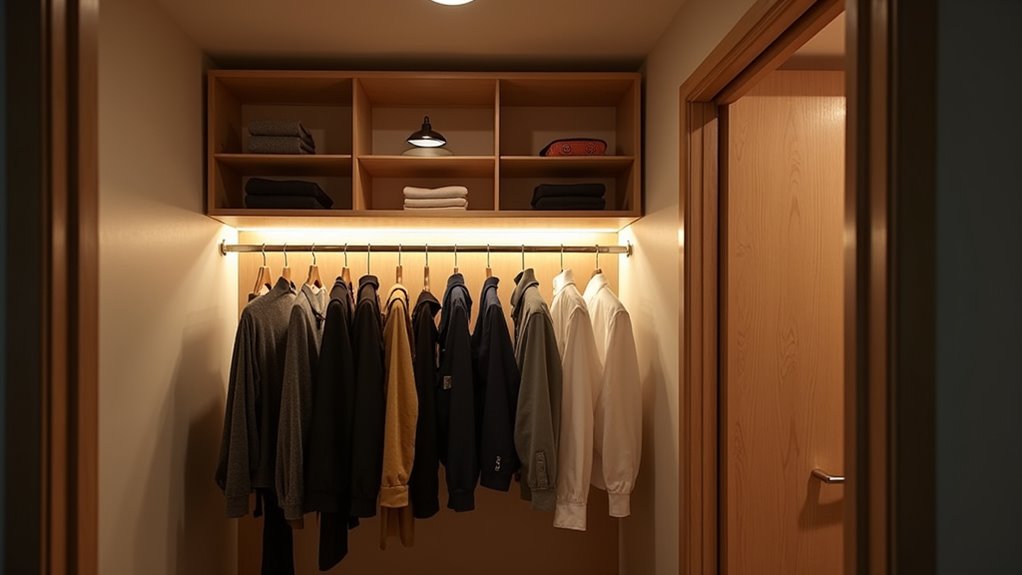
Motion sensor and wireless lighting solutions eliminate manual switches while delivering immediate, hands-free illumination when you enter your closet. Passive infrared (PIR) sensors detect movement within a 100–120-degree range, activating lights instantly and shutting them off after preset intervals to conserve energy. Battery-powered and USB-rechargeable fixtures install without electrical work, using magnetic strips or adhesive mounts that adapt to any wardrobe configuration. LED strip lights are energy-efficient and suitable for confined spaces since they emit low heat during operation. Many rechargeable models offer 2.1 months of battery life when activated eight times daily for 20 seconds each. When selecting fixtures online, be aware that security service protections may temporarily block access to lighting retailer websites if certain search terms or data triggers automated safeguards.
Integrated Motion Sensor Benefits
When you’re juggling armfuls of clothing or accessories, the last thing you need is fumbling for a light switch in the dark, and that’s precisely where integrated motion sensor technology transforms your closet experience. These sophisticated systems deliver hands-free illumination while offering adjustable sensing settings that adapt to your specific spatial requirements and movement patterns.
The aesthetic and functional advantages include:
- Seamless architectural integration that eliminates visible switches, preserving your closet’s clean lines and minimalist design language
- Smart home connectivity enabling remote monitoring and customized brightness profiles through your smartphone or tablet
- Extended LED longevity through intelligent activation cycles, with some advanced models featuring energy harvesting capabilities
This technology boosts accessibility for users with mobility limitations while reducing your carbon footprint through precision-based illumination control. Motion-activated closet lighting can reduce energy consumption by 50-75% compared to traditional lighting left on for extended periods, delivering substantial cost savings over time.
Battery-Powered Wireless Convenience
Since traditional hardwired installations aren’t feasible in every closet configuration, battery-powered wireless fixtures deliver professional-grade illumination without compromising your space’s architectural integrity. Modern rechargeable systems eliminate disposable cell dependency while maintaining exceptional battery duration; high-capacity models achieve 90-day cycles between charges.
| Fixture Type | Battery Duration | Light Output |
|---|---|---|
| LED Puck Lights | 100 hours | 55 lumens |
| Rechargeable Strips | 2–4 weeks (sensor mode) | 350 lumens |
| Ceiling Panels | 90 days per charge | 500 lumens |
Wireless setup requires no electrical expertise, adhesive backing and magnetic mounts enable instant installation. Motion sensors with 10-foot detection ranges and 120-degree coverage angles activate illumination automatically, while dual-mode functionality (daylight/night) optimizes energy consumption. USB-rechargeable batteries reduce long-term operational costs substantially.
Brightness and Lumen Requirements by Closet Size
Determining the correct lumen output begins with evaluating your closet’s square footage and configuration. Small closets under 20 square feet function ideally with 150–400 lumens, while standard reach-in spaces require 400–800 lumens to eliminate shadows across shelving and hanging areas. Walk-in closets demand substantially higher output, typically 800–1,500 lumens for spaces up to 100 square feet, with larger layouts necessitating 1,500–3,000+ lumens depending on ceiling height and surface finishes.
Small Closet Lumen Needs
Although small closets occupy minimal square footage, their lighting demands precision to guarantee every garment, accessory, and shelf remains clearly visible. For spaces measuring 12–25 square feet, you’ll need 200–250 total lumens to achieve ideal closet lighting distribution. Calculate your requirements by multiplying square footage by 10 footcandles; a 20-square-foot closet requires approximately 200 lumens baseline.
Consider these targeted lumen allocations:
- Upper shelving zones: 100–150 lumens via LED strips positioned along shelf edges
- Rod-level circulation: 80–100 lumens distributed through linear fixtures flanking hanging garments
- Localized task lighting: 300–400 lumens per square meter near mirrors or dressing areas for detailed work
Deploy at least two light sources rather than relying on a single central fixture. This multi-point approach eliminates shadows while ensuring color accuracy through fixtures rated 80+ CRI.
Walk-In Closet Requirements
Walk-in closets transform from simple storage into curated dressing environments when you apply the correct lumen calculations to their expanded square footage. Target 200–300 lumens per square meter for baseline illumination, an 8 m² space demands approximately 2000 lumens distributed through multiple fixtures. Your closet organization layouts dictate lighting strategy: task zones near mirrors require heightened intensity at 300–400 lumens/m², achieving 200–500 lux for accurate color assessment during dressing. Built-in lighting fixtures, recessed cans, track systems, or flush-mounts, provide even ambient coverage, while supplemental strips eliminate shadow zones beneath shelving and hanging sections. Spaces exceeding 12 square feet necessitate 400+ lumens minimum, scaled proportionally with size. Deploy directional spots for display areas and adjustable pendants in high-ceiling installations to maintain consistent foot-candle levels throughout.
Energy Efficiency and Long-Term Cost Savings
When selecting closet lighting fixtures, energy efficiency directly impacts both your utility expenses and long-term ownership costs. LED technology delivers the most compelling return: consuming 75% less energy than incandescent alternatives while providing 25,000 operational hours. This translates to measurable long-term electricity savings and reduced replacement frequency. Many utility company incentives further offset initial investment through rebates on efficient fixtures.
Consider these cost-reduction strategies:
- Motion-sensor integration eliminates accidental all-day operation, preventing unnecessary power consumption in spaces accessed only intermittently
- Smart dimming controls calibrate output to actual needs, maximizing lumens-per-watt efficiency during brief retrieval tasks
- LED strip placement under shelving delivers targeted task illumination without over-lighting the entire volume
The cumulative effect typically recoups upfront expenditure within two to three years through decreased billing cycles.
Color Temperature Considerations for Accurate Clothing Selection
Color temperature directly influences how accurately you perceive garment hues and textures within your closet environment. The ideal range of 3000K–4000K balances the warmth that flatters skin tones with the clarity needed for precise color differentiation during outfit selection. Understanding the distinction between daylight-mimicking cool whites (4000K–5000K) and softer warm whites (2200K–3000K) enables you to select fixtures that align with both your aesthetic preferences and functional color-matching requirements.
Ideal Kelvin Range Explained
Light temperature fundamentally transforms how you perceive the colors in your wardrobe, making the selection of an appropriate Kelvin range essential for accurate clothing assessment. The optimal spectrum lies between 3500K–4000K, delivering neutral white illumination that guarantees chromatic fidelity without distortion.
Alternative kelvin options compromise accuracy, lights below 3000K introduce amber casts that obscure blues and whites, while fixtures exceeding 5000K impart clinical blue tones that diminish warm hues. This precision matters because wardrobe coordinating errors stem directly from chromatic inconsistency.
Consider how this range functions:
- Retail environments utilize 3500K–4000K in fitting rooms for authentic color matching
- Neutral white minimizes metamerism, preventing daylight appearance discrepancies
- Balanced illumination supports differentiation between subtle fabric tones and prints
Pair this temperature with 90+ CRI bulbs for thorough color rendering accuracy.
Daylight Versus Warm White
Your closet’s color temperature determines whether you’ll perceive garments authentically or through a distorted chromatic lens. Daylight LEDs (5000K–6500K) replicate natural sunlight conditions, ensuring accurate differentiation between subtle shades, critical when pairing navy versus black or identifying fabric wear. Warm white (2700K–3000K) introduces amber casts that compromise color fidelity, creating mismatches in your wardrobe selections.
While warm illumination augments closet decor perception through inviting ambiance, it fails functional inspection tasks. Daylight fixtures excel in windowless spaces, providing crisp brightness that reveals true whites and nuanced undertones. This temperature also emphasizes textile texture emphasis, exposing weave details and surface imperfections invisible under yellow-toned lighting. Cool illumination may feel clinical initially, yet its precision prevents morning outfit errors. Balance visual comfort against accuracy needs, daylight consistently outperforms for clothing evaluation.
Installation Requirements and Mounting Flexibility
- Surface-mount LED panels positioned directly above hanging garments, eliminating shadows across textured fabrics
- Recessed downlights creating clean ceiling planes in contemporary closet architecture
- Under-shelf LED strips illuminating vertically stacked storage without visual clutter
Non-licensed installers should select plug-in or battery-powered models to circumvent electrical permitting. Modular LED systems typically include mounting hardware for straightforward user installation.
Smart Home Integration and Remote Control Features
How can modern closet lighting transcend basic illumination to become a responsive, intelligent extension of your daily routine? Smart integration transforms your closet into a seamlessly controlled environment. Through platforms like Alexa, Google Assistant, and Apple HomeKit, you’ll command customizable lighting scenes via smartphone apps, hands free voice controls, or automated scheduling based on occupancy patterns.
| Control Method | Primary Function | Best Application |
|---|---|---|
| Voice Command | Hands-free adjustment | Morning routines |
| Motion Sensors | Automatic on/off | Energy efficiency |
| App Interface | Scene customization | Multi-zone control |
| Preset Routines | One-touch recall | Daily consistency |
Color temperature adjustments, dimming capabilities, and energy analytics empower you to optimize both functionality and consumption, ensuring your lighting adapts intelligently to every task while maintaining architectural cohesion throughout your home ecosystem.
Frequently Asked Questions
How Do I Calculate the Total Number of Fixtures Needed for My Closet?
Calculate your total fixtures by initially determining your closet’s square footage, then multiplying by the appropriate footcandle level (20-50 for residential closets). This yields your required lumens. Divide that number by each fixture’s lumen output to establish quantity needed. Your lighting layout considerations should address uniform spacing and dark zones, while lighting power requirements depend on surface reflectance and ceiling height. Account for a 15% light loss factor, and adjust fixture placement around shelving divisions for ideal coverage.
Can Closet Lighting Fixtures Be Used in Humid or Damp Environments Safely?
Yes, you’ll need moisture-resistant options like vapor-tight LED fixtures rated IP65 or higher for humid closets. These sealed units prevent water ingress and corrosion while maintaining electrical safety. You should verify fixtures are UL-listed for damp or wet locations and feature gasketed seals protecting internal components. Consider ventilation requirements, pairing fixtures with dehumidifiers or exhaust fans extends their lifespan. Choose fully enclosed designs rather than exposed bulbs, and guarantee proper installation by qualified electricians for code compliance.
What Maintenance Is Required to Keep Closet Lights Functioning at Peak Performance?
You’ll need periodic cleaning with a soft cloth to remove dust that diminishes light output and compromises fixture efficiency. Guarantee proper heat dissipation by maintaining required clearances, 12 inches for surface-mounted fixtures and 6 inches for recessed installations. Monitor bulb performance regularly, replacing any flickering or dimming components immediately. Keep ventilation openings clear, verify that bulbs remain fully enclosed within their housings, and inspect for physical damage. These practices preserve ideal illumination while extending your fixture’s operational lifespan drastically.
Are There Fire Safety Codes or Regulations for Closet Lighting Installation?
Yes, the NEC mandates specific closet lighting requirements to mitigate fire hazard risk. You’ll need to maintain minimum clearances: 12 inches for surface-mounted incandescent/LED fixtures, and 6 inches for recessed or fluorescent installations. Completely enclosed light sources are essential, as pendant fixtures are strictly prohibited. While ventilation requirements aren’t explicitly codified for standard closets, proper airflow prevents heat accumulation near combustible materials. You must guarantee fixtures are specifically rated for closet storage applications to maintain compliance and safety.
How Do I Troubleshoot Flickering or Dimming Issues With My Closet Lights?
Start by checking if your bulb’s securely seated and compatible with any dimmer switches; non-dimmable LEDs will flicker persistently. Inspect wire connections at the fixture and switch for looseness, as faulty terminations pose fire hazards. If you’re using motion-activated fixtures, erratic sensor activation can mimic dimming issues; verify motion detection triggers aren’t interfering with power delivery. Test the circuit load; appliances on shared lines cause voltage drops. Replace poor-quality LED drivers and confirm your breaker connections are tight.

